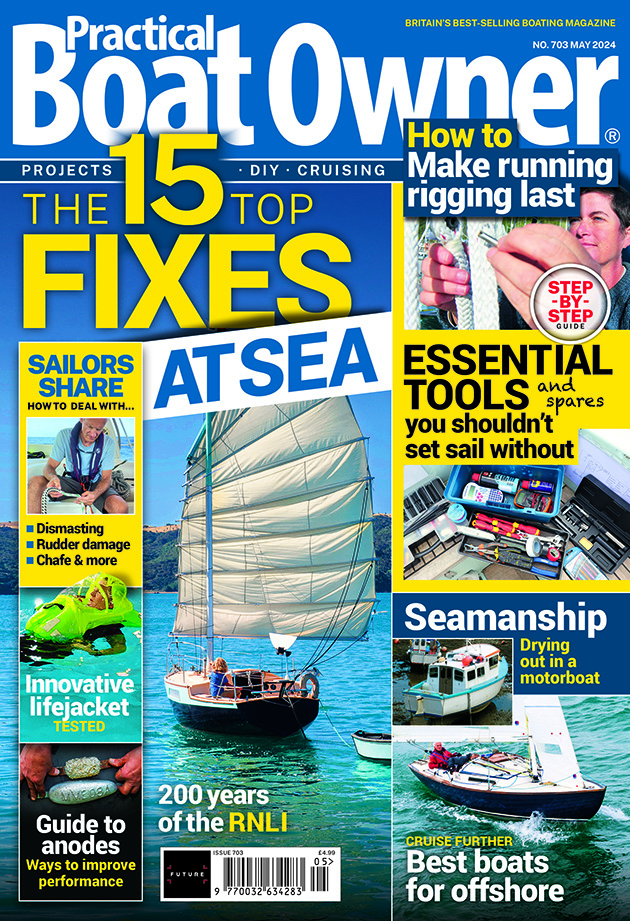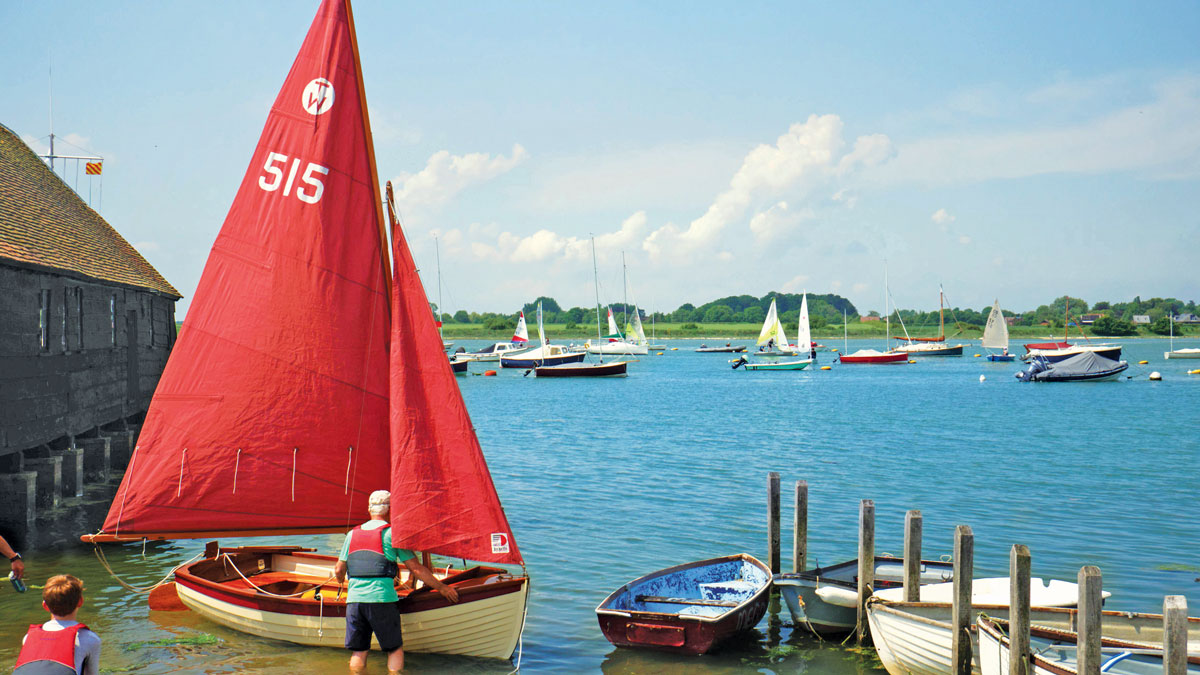Clive Marsh shares why those looking for a smaller boat should consider the Westerly Cirrus and Tiger
Taking a short break at the Mill Stream Hotel in Bosham with the family, I was mainly walking and exploring the delights of the wonderful Chichester Harbour.
A good breakfast, a nice walk followed by afternoon tea and cakes at the old hotel, perfect.
Just by chance, we wandered through the car park at Bosham and there was Ella, a nice fin keel Westerly Super Cirrus, all chocked up and looking for a new owner.
I can be a bit impulsive when it comes to boats and decided to buy her there and then.
She looked sound enough to me and was being offered at a fair end-of-season price.
My plan was to leave her in the yard and prepare her for a launch in the early spring. It was a delight visiting the yard in the winter and getting to know the locals in the Anchor Bleu.

Rowing back from Ella with mate Maurice. Credit: Clive Marsh
An inevitable list of things to do was made and I needed to start with that lump of metal under the stairs that was described as a Vire 6hp petrol engine.
This was quickly removed and rebuilt along with all the stern gear and ancillary equipment.
All seacocks and skin fittings were removed and replaced with new gear.
The interior headlining was removed and the boat painted/varnished inside and out.
The hull’s gelcoat was buffed up and beneath the waterline, old antifouling was removed before new primer, undercoat and two coats of antifouling were applied.
All running and standing rigging was replaced and the bent rudder stock straightened.

Clive’s old Westerly Cirrus Ella just launched after her clean up. Credit: Clive Marsh
She was beginning to look good and was rigged and launched on the first of April!
Her sails were in good condition and my mate accompanied us on her early little passages.
The engine started directly but being a single cylinder was named ‘old thumper’ on account of the heavy banging we had to tolerate.
This was an incentive to get sailing as soon as possible, which she did very well.
We’d sail over to East Head, Hayling Island and sometimes over the bar to enter the Solent.
Continues below…
Lune Pilot 11: why you should sail this fine, little boat
A very interesting boat with a long keel, which makes it slightly unusual for a dinghy
Tideway 12: seaworthy and stable
Prolific boat owner Clive Marsh extols the virtues of the Tideway 12, which can be launched by hand from a
Westerly Konsort: space, security & good performance
One of the roomiest cruisers of her size, the Konsort is also known for her solidity, interior finish and easy…
Sailing surfboats: Lasers, the Lightning 368 and more!
Clive Marsh looks at sailing surfboats - the Seabat, Minisprint, Lightning 368 and more!
Everything worked, although at times she would sail with a slight corkscrew- type motion on account of her short waterline length.
But there was a recurring problem whenever it was time to return to base.
I always like to have the engine running when crossing the bar to enter the harbour but try as we may it simply would not start.
So, we had to sail in and up the narrow Bosham Channel to pick up our mooring against the ebb stream and sometimes the wind.
All good practice of course but I would have preferred a more relaxing end to the day.
Every time we went out the engine started easily but it would not restart to get us back after our sail.
This continued for some months until we discovered that our petrol tank was rusty.
The sailing shook it all up and interrupted the petrol flow to the carburettor.
Pat the boatman at Bosham diagnosed this for us, it seems obvious now but was not at the time.
A new tank was fitted and that funny old thumper was as reliable as a new diesel engine which I could not afford but everyone told me I should buy.

The Westerly Cirrus Popard is lifted in. Credit: John Dowling/WOA
Probably the worst job was removing the sagging headlining in the cabin. This was very dusty and we wore masks and goggles although these were not adequate.
Certain jobs are best left to tradespeople who should have all the right gear.
For a small yacht of just 22ft in length the Westerly Cirrus packs a lot of space inside.
It’s clever how the designer, John Butler, and Westerly builders achieved full standing headroom in the cabin for people not more than 6ft tall and there is a separate cabin with berths forward.
Plus there’s a separate heads compartment, drying locker, dining area, galley, quarter berth and a spacious cockpit.
The Cirrus is solidly built with wide side decks which makes going forward easy. There’s no need to clamber over a slippery cabin top.
Ella’s main sail was reefed around the boom which utilised a claw with rollers to take the kicking strap.
The genoa, working jib and storm jib were all of the hank-on type. She also had a cruising chute.
Some boats utilise a roller reefing jib with lines led aft to make single-handed sailing easier.
I just lashed my jibs along the safety wire and it was a simple job to attach the halyard etc to the required jib.
The Westerly Cirrus was described as a cruiser-racer and was outright winner of the 1968 Yachting World Rally.
Nearly 400 were built over a five-year period and there are always a few on the market with prices starting as low as £500 for a project boat version, up to £5,000 for a refurbished model.
Right now, small pocket cruisers seem to sell for the price of a decent sofa!
The Westerly Cirrus has a bigger 25ft sister called the Tiger, a very similar looking boat of which 284 were built.
From a distance, the Westerly Cirrus and the Tiger can easily be mistaken for each other.
But, when buying a low-cost yacht, remember that the running costs and mooring fees can be heavy – annual fees can be more than the cost of the yacht.
Also, most small yachts are used like day-sailers but have the limitation of sailing venues compared to a dinghy that can easily be transported to different cruising grounds on its trailer.
Another disadvantage of a cruising yacht is having to keep her afloat and then craned in or out for antifouling.
Cruising yachts from the 1960s are well laid up but often have no positive buoyancy.
This became very clear to me when Ella was holed at her mooring and sank like a brick. Ballast of 1,460lb and no positive buoyancy or watertight bulkheads were an issue.
Lack of positive buoyancy was a common feature of older cruisers and may still be the case, but that’s a subject for another day.
Ella was raised, sorted out, re-engined and is doing just fine – testimony to her solid construction.
Westerly Cirrus specifications:
Designer: John Butler
Builder: Westerly
LOA: 22ft/6.71m
Beam: 8ft/2.44m
Draught: 3ft 6in/1.07m
Displacement: 3,240lb/1,470kg
Ballast: 1,460lb/660kg
Berths: 4
Heads: 1
Rig: sloop
Main: 100ft2/9.3m2
Genoa: 166ft2/15.5m2
No1 jib: 110ft2/10.2m2
Tiger specifications:
Designer: John Butler
Builder: Westerly
LOA: 25ft 8in/7.64m
Beam: 8ft 9in/2.67m
Draught: 4.25ft/1.30m
Displacement: 5,264lb/2,388kg
Ballast: 2,240lb/1,016kg
Mainsail: 154ft2/14.3m2
Genoa: 226ft2/21.2m2
No1 jib: 133ft2/12.4m2
Enjoy reading Westerly Cirrus and Tiger: two excellent fast cruisers that can now be bought for the price of a decent sofa!?

A subscription to Practical Boat Owner magazine costs around 40% less than the cover price.
Print and digital editions are available through Magazines Direct – where you can also find the latest deals.
PBO is packed with information to help you get the most from boat ownership – whether sail or power.
-
-
-
- Take your DIY skills to the next level with trusted advice on boat maintenance and repairs
- Impartial in-depth gear reviews
- Practical cruising tips for making the most of your time afloat
-
-
Follow us on Facebook, Instagram, TikTok and Twitter








